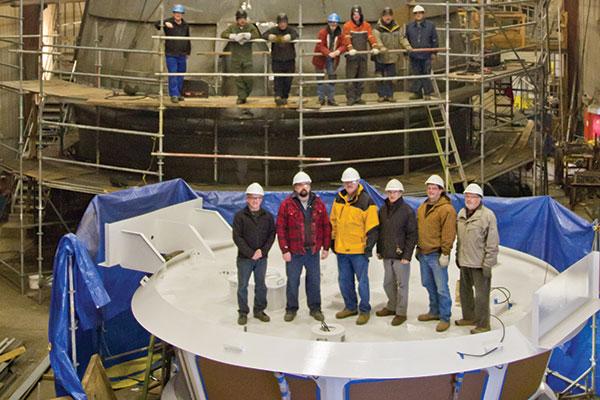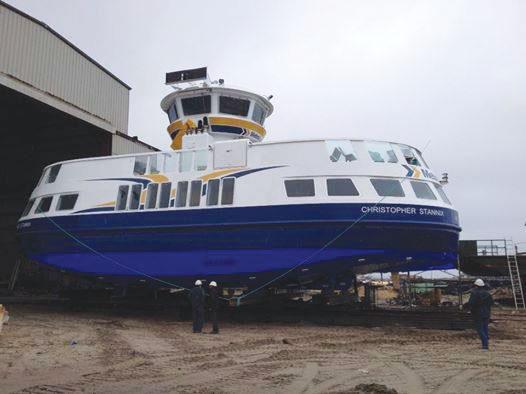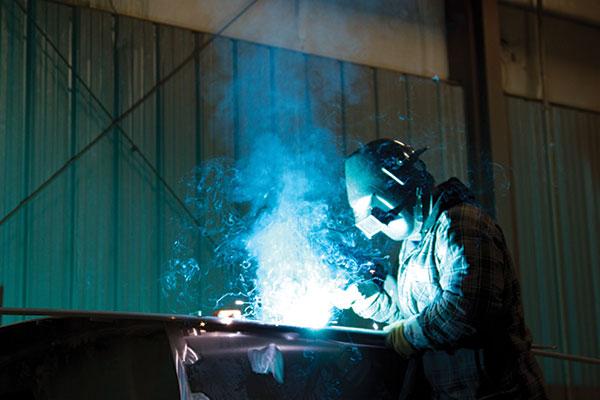- FMA
- The Fabricator
- FABTECH
- Canadian Metalworking
Navigating a Maritime Manufacturer
A. F. Theriault & Son builds vessels for pleasure and target practice
- By Sue Roberts
- May 8, 2014
- Article
- Fabricating

The management team of A. F. Theriault & Son stands on top of the wheel house for the ferry in the background (left). From left to right: Graham Oakley, vice president-new construction; David Theriault, production manager-new construction; Larry Theriault, secretary; Everett Titus, superintendent; Gilles Theriault, general manager; and Arthur Theriault, president. Finished vessel shown above.
Any maritime pilot will tell you that ship handling is complex. It requires a full understanding of maritime laws, weather patterns, and the vessel and crew under command. Safe passage means knowing the current location; charting the route; and responding to uncontrollable winds, tides, and swells while staying on course.
Maneuvering a company through the ebb and flow of the business world takes a similar high level of dedication, diligence, and ability. Guiding a company to growth takes knowledge of government regulations, product specifications, and company strengths, along with the ability to respond to unanticipated changes from the marketplace and within the walls of the plant.
On the southwest coast of Nova Scotia, midway between the Bay of Fundy and Annapolis Valley and the Yarmouth and Acadian Shores, the team at A.F. Theriault & Son Ltd., in the midst of its 76th year of boat building, is piloting the company to success. Throughout the years the family-owned and -operated company has stayed the course, grown the crew to 125, and expanded its reach to provide vessels that cruise waters across the globe.
Documents dating back to 1938 record the building of 692 vessels in the Meteghan River/Baie Ste-Marie boatyard. Original entries were penned by company founder Augustin François, grandfather to Gilles Theriault, general manager, and his cousin David Theriault, production manager-new construction. Arthur Theriault, Augustin’s son, company president, and Gilles’ father, followed suit by recording vessels built after he took the helm in 1980. Today the responsibility of tending the company log is shifting to the next generation.
“We’ll never know what motivated our grandfather to create this company,” Gilles said. “There were multiple boatyards along this coast. He lost money when he started building wooden fishing boats, but he and my grandmother were hard workers and they kept at it.
“He got awarded a government contract to build a ferry and that was profitable. Then the fishing industry got stronger and he kept building wooden boats for multiple species— scallops, herring, cod, and lobster— for competing seafood companies that both needed multiple vessels. These vessels were fairly large, 100 feet long. At the same time he was building for local fishermen.”
Gilles continued, “In 1980 my father, Arthur, and his brothers, Ernest, Russell, and Larry, stepped up to the plate to move the company forward.”
New Materials Add Sales
The second generation recognized that the company needed two things to grow. It needed to expand the working space and introduce capabilities to use materials in addition to wood.
In 1988 the existing structures were torn down and replaced with steel buildings outfitted with equipment and cranes to work with steel, aluminum, fiberglass, and advanced composites.
Today’s yard stretches along ½ mile of bay frontage. New vessels are launched into Baie Ste-Marie from one slip. Boats needing repair enter one of three additional slips in the repair wharf during high tide. At low tide, the water recedes 17 ft., leaving the hull, rudders, or propellers exposed for work as needed.
A dozen buildings house specific tasks—inventory for repairs is in the stockroom, woodworking takes place in the mill, and finishing for high-end furniture occurs in the paint shop. Aluminum vessels are built in one boat shop, fiberglass in another, and iron in yet another. Welding processes have their own location, and company equipment is repaired in the machine shop. Maintaining a bit of local tradition, the exterior of an old Meteghan River school located on the property was maintained, but the interior was converted to accommodate the propeller repair shop.
Custom Focus Grows Customer Base
The expansion and new capabilities keep the company moving fullsteam ahead. As the third generation moves up the chain of command, A.F. Theriault & Son is positioned to increase market share.
“We’ve been fortunate because we got government contracts to build ferries. We also secured contracts to build steel and fiberglass fishing boats and got into the pleasure boat market. When the economy was booming, we began building 65-foot yachts out of steel, and catamarans out of aluminum and fiberglass,” said Gilles.
Competitors clustered along the shore in the 1940s are gone, but expanding the custom-build business invited new competition from a variety of locales. “We have diversified and now do so many different things … we will compete with regional boatyards for a lobster boat for a local customer or with other builders for a ferry for the government. We competed against U.S. boatyards for the fireboats we built for Portland and Boston,” Gilles said.
Ninety percent of a new vessel is built on-site. The remaining 10 percent comprises the main engine, specified by the client, and the electronics, which are provided by other sources but wired in place as the vessels are built. “We pretty much have a turnkey operation. We can sit in this office and create a contract and specifications for a vessel. You give us some money and in nine months we give you a product,” said Gilles.
Typically there are 10 to 12 vessels going through the company at a time, depending on the complexity of their designs.
Graham Oakley, vice president of new construction, explained that for new vessels, the company provides the files to a steel service center that fabricates the majority of parts. “We create most of our cut files from the design package provided by the client. We take the basic drawings, do the plate expansions, nest the parts, and send the files off for cutting. It speeds production.” Some flanges, small parts for new construction, and repair parts that are not in stock are produced on the in-house shear, bender, plate roll, and plasma table.
Welding equipment for steel and aluminum—submerged arc, wire feeder, and a lot of stick—is scattered among the buildings and manned by more than 20 certified welders. Many of the welders are trained in-house, with a healthy percentage coming from the community college.
Oakley said, “There’s a constant stream of redoing certifications and training young people. We try to get all the welders trained and with as many certifications as possible so they can go to the different stations. And we are always upgrading the machines.”
Advancing the Art of Shipbuilding
The actual structures of vessels haven’t changed much in the past 30 to 40 years, according to Oakley. What has changed is the quality of materials and the technology built into the boats.
“It’s clearer as to what grades of material are suitable for what applications,” said Oakley. “Steel has improved, and the coatings we apply to extend the life of the material are better.”
Designers are getting away from wood linings and paneling, moving to honeycomb aluminum for its durability, lighter weight, and fire resistance. Aluminum extrusions are replacing wood for shapes and corners like window and door frames. “By using the aluminum you get away from varnish. Instead of having people cutting, sanding, varnishing, and drilling screw holes in wooden moldings, we use adhesives and extrusions that snap together. Sometimes the cost is a little higher than working with wood, but you get a better product. And the component is lighter weight. Reducing the weight of anything that is above the deck improves the vessel’s stability,” said Oakley.
“A boat’s equipment gets outdated and the electronics in the new vessels are completely different from just a few years ago. The ferries being replaced in Halifax all have big wheels with the mechanical linkage connected to drives throughout the boat. The new ones are going to be fly-by-wire joysticks. It will be a different experience for the pilots,” Oakley added.
Tradesmen Start Here
Gilles appreciates the government’s Ships Start Here initiative even though he doesn’t anticipate being a direct recipient of much of the work.
“Right now they are building navy ships and there is not a lot of equipment on them, so the shipyard is pretty much going to do its own production. We’re hoping that the program will help us in the future by encouraging young Nova Scotians to venture into the trades. Jobs that are created because of the government program will encourage young people to work with their hands and become plumbers, carpenters, and welders. This is important for the future of our company, our industry, and Nova Scotia,” Gilles said.
“We are also hoping that part of the program funding will provide some work opportunities. There is money allocated for 117 vessels under 1,000 tons, the size boat we can bid on.”
The Pleasure of Boats
Boat building isn’t all working with hard edges of wood and metal and columns of numbers. A personal touch comes into play, particularly when dealing with pleasure crafts.
Gilles described an unusual situation that occurred because of his grandfather’s work in converting a government vessel to a pleasure boat named Capture that was launched in the early 1950s.
“The elderly daughter of the people who commissioned the job came to the boatyard a few years back. She said that her father had so much fun on the Capture that he requested that his ashes be sprinkled where the vessel was launched. So we went out and respected her father’s wishes.”

Roy Thibodeau, tinsmith, and Robert Small, finish carpenter, work in the wheel house for the ferry being built for the Halifax Regional Municipality. It will be completed with all wiring, air lines, interior lighting, air conditioning, and insulation before being welded in place.
AFT-built Hammerheads Sharpen Military Defense Skills
One contract accounted for a large percentage of the work passing through the new construction division of A.F. Theriault & Son Ltd. in 2013. According to Gilles Theriault, general manager, that contract was for 17-foot fiberglass Hammerhead drones built for Meggitt Training Systems Canada Inc.
The Hammerheads are unmanned surface vehicle targets (USV-T) that were developed in response to the 2000 terrorist attack by a suicide bomber in a small boat on the USS Cole. Gunners could shoot from ship to ship but were not successful in defending against small crafts approaching the hull of their ship.
The USV-Ts replicate fast inshore attack crafts (FIAC) by approaching the ship at up to 40 knots. Their movements can be preprogrammed or remotely controlled for defense practice sessions.
On Jan. 24, A.F. Theriault & Son, the sole provider of the Hammerhead vessels, and Meggitt Training Systems celebrated the completion of the 250th Hammerhead. The Royal Canadian Navy and military in several other countries use the Canadian-developed and -produced vessels for training.
subscribe now


Keep up to date with the latest news, events, and technology for all things metal from our pair of monthly magazines written specifically for Canadian manufacturers!
Start Your Free Subscription- Trending Articles
- Industry Events
MME Winnipeg
- April 30, 2024
- Winnipeg, ON Canada
CTMA Economic Uncertainty: Helping You Navigate Windsor Seminar
- April 30, 2024
- Windsor, ON Canada
CTMA Economic Uncertainty: Helping You Navigate Kitchener Seminar
- May 2, 2024
- Kitchener, ON Canada
Automate 2024
- May 6 - 9, 2024
- Chicago, IL
ANCA Open House
- May 7 - 8, 2024
- Wixom, MI

















